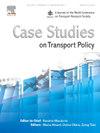Using multiplayer simulation to evaluate incentive-based strategies for reducing congestion and carbon emissions: A case study of campus travel in Huainan, China
IF 3.3
Q3 TRANSPORTATION
引用次数: 0
Abstract
The debate between price-based and quantity-based approaches to carbon regulation has been a longstanding focus among scholars aiming to control emissions and advance low-carbon development. This study explores and compares the effects of two intervention models on individuals’ low-carbon travel decisions. Using Huainan in China as a case study of urban campus travel, we employed a multiplayer online simulation experiment conducted on the ZTree platform. The experimental scenario simulated short-distance leisure travel (within 5 km) under three conditions: no intervention, price-based intervention (via a travel-mode tax), and group-targeted intervention (via a shared carbon emission quota). A total of 600 campus travelers were organized into 20 groups of 30 participants. Across 30 rounds of decision-making, participants selected transport modes under varying policy scenarios. The findings revealed that both interventions effectively reduced traffic congestion and carbon emissions, with the group target-based intervention demonstrating more consistent and robust effects. Additionally, both psychological factors (attitude, subjective norms, perceived behavioral control, intention, face consciousness, and habits) and demographic factors (gender, age, income, family structure, private car ownership, and housing status) predict changes in participants’ traffic-related carbon emissions before and after the experiment, with demographic factors exerting a stronger influence overall. This study offers empirical evidence to inform policy design aimed at reducing urban traffic congestion and transport-related carbon emissions, particularly within university commuting contexts in medium-sized Chinese cities.
使用多人模拟评估基于激励的交通拥堵和碳排放减少策略——以淮南市校园交通为例
长期以来,以价格为基础和以数量为基础的碳监管方法之间的争论一直是旨在控制排放和推进低碳发展的学者们关注的焦点。本研究探讨并比较了两种干预模式对个体低碳出行决策的影响。以中国淮南市为例,在ZTree平台上进行多人在线模拟实验。实验场景模拟短途休闲旅游(5公里以内)在三种情况下:无干预、基于价格的干预(通过旅行模式税)和群体目标干预(通过共享碳排放配额)。共有600名校园旅行者被分成20组,每组30人。在30轮决策过程中,参与者在不同的政策情景下选择交通方式。研究结果表明,两种干预措施都有效地减少了交通拥堵和碳排放,其中基于群体目标的干预效果更加一致和稳健。此外,心理因素(态度、主观规范、感知行为控制、意图、面孔意识和习惯)和人口因素(性别、年龄、收入、家庭结构、私家车拥有量和住房状况)都能预测实验前后参与者交通相关碳排放的变化,人口因素的影响总体上更强。本研究为旨在减少城市交通拥堵和交通相关碳排放的政策设计提供了经验证据,特别是在中国中等城市的大学通勤环境中。
本文章由计算机程序翻译,如有差异,请以英文原文为准。
求助全文
约1分钟内获得全文
求助全文

 求助内容:
求助内容: 应助结果提醒方式:
应助结果提醒方式:


